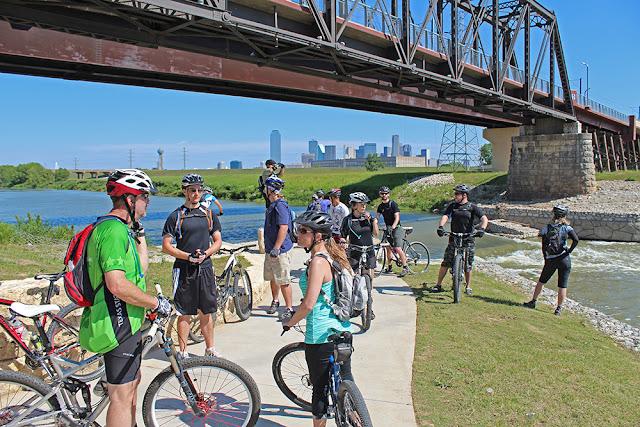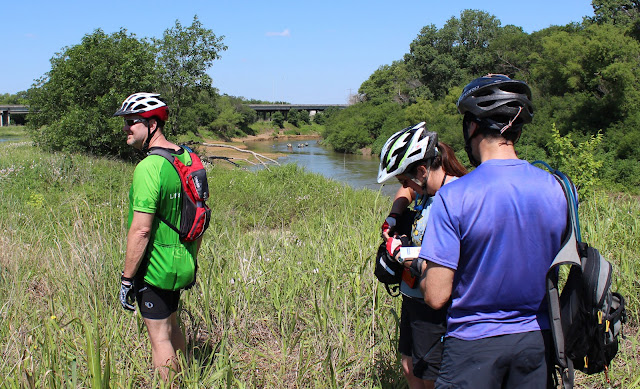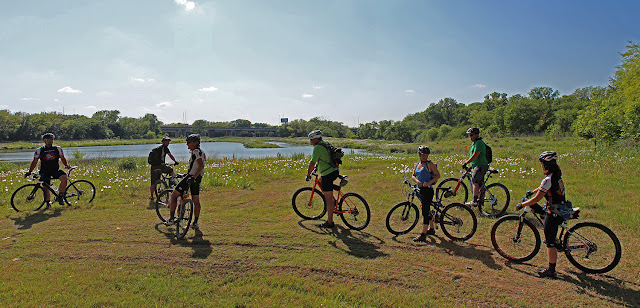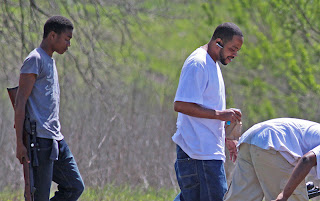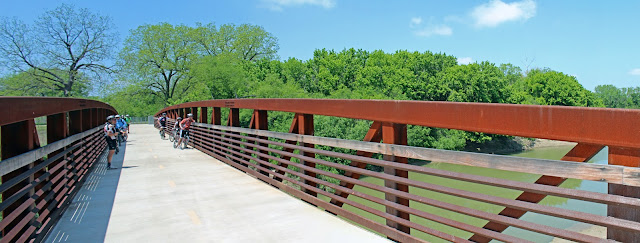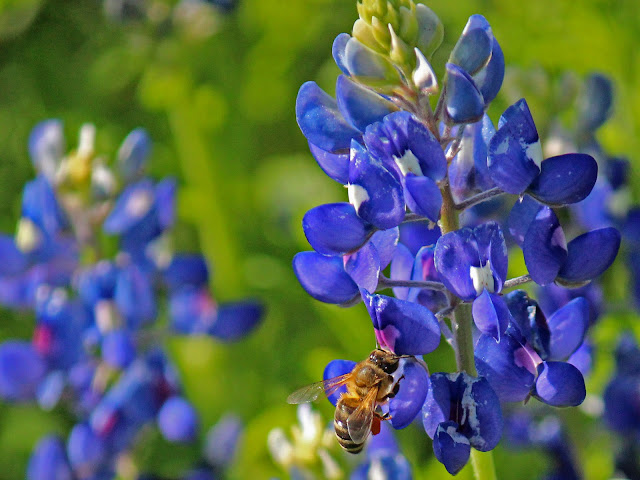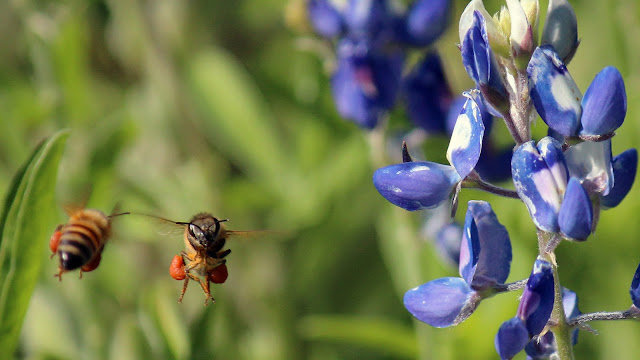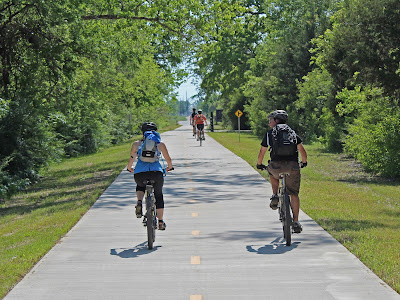Exploring The Great Trinity Forest Trails — Is that Michael McNair? Why Yes it is!
 |
| Cycling hero Michael McNair on his first bike ride back into the Great Trinity Forest, near Freedman’s Town of Joppa, Dallas, Texas April 28, 2013 |
The face of courage, victory and overcoming impossible odds. If there was one cool picture that I find remarkable more than any other I have taken on the Trinity River, this one was it. I could print that photo off and take copies to the ICU wing at Baylor Hospital, without caption and make jaws hit the floor. He made it. Back. That’s what a champion looks like folks. I’d made the mistake of assuming this day would never come.
There are a rare few weeks in a North Texas spring when the sun shines brighter, the wildflowers taller and the sky bluer than any other place on Earth. Then there are those few special days inside those weeks. The ones where everything is just as perfect as it gets. I’d like to think that the weather is what made a trip down to the river special. It was just a minor footnote to what was probably one of the great human resurrections of all time. Michael McNair. It could have rained, snowed and hurricaned that fine April day and I don’t think that could put a damper on what was witnessed.
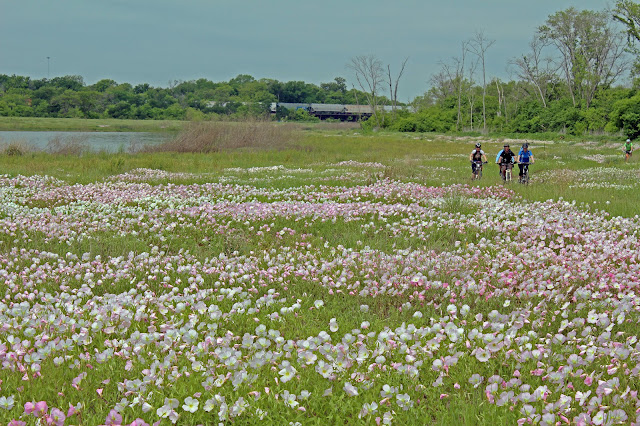 |
| Michael McNair leading the way through knee high wildflowers in the Trinity River Wetlands |
His story over the last year has filled the airwaves, been printed in the newspaper and in print magazines. Take time to read his remarkable story and the story of his remarkable family who in the face of incredible challenges, just keep on cranking:
Tim Rogers December 2012 article in D Magazine about Michael:
http://www.dmagazine.com/Home/D_Magazine/2012/December/Why_Does_Dallas_Hate_Cyclists.aspx
You know you are in trouble if John McCaa leads off the evening news with your name:
http://www.wfaa.com/news/local/Cycling-advocate-recovering-after-being-struck-by-car-151959175.html
Dallas Morning News puts you in ink usually means you are in the hospital, jail or dead:
http://www.dallasnews.com/news/community-news/dallas/headlines/20120518-dallas-bike-advocate-mike-mcnair-seriously-injured-by-car.ece
About a year ago, May 15, 2012, Michael was struck down by a motorist while riding his bike. Critically injuring him in ways that few people ever recover. Lungs, compound fractured ribs, broken hip, pelvis, back, neck, skull, internal injuries of vital organs like his spleen. The medical staff at Baylor put his chances of recovery at a low 15%. Grim. Things only got worse from there as infections racked across his weakened body. In a coma, living off breathing machines in the ICU wing. It was around Memorial Day when I thought to myself that his days of riding were very much over. No way would he make it back. Just improbable. His wife Heather was by his side everyday at the hospital, she never gave up. She knew that someday he would pop back up and get back to riding.
All too often I get to know folks who are far to modest about their accomplishments. He had to learn to walk again. A continuing road to recovery that is full of obstacles and a mile high. He was still walking with a cane the last time I saw him. He is fearless. Tougher than you. Tougher than me.
Michael has been tapped to serve as the lead rider at the Ride of Silence on May 15, 2013 at White Rock Lake: http://www.rideofsilence.org/main.php
One year to the day that he was hit by a car. It’s just a sheer miracle that he is still with us.
Also, if you know them, give Matt Malone and Mike Freiberger an attaboy slap on the back the next time you see them. Matt and Mike are some real unsung badasses in helping the McNair family the past year. Those guys lived at Baylor all last summer, did home renovations to make the McNair home wheelchair accessible and much more. A big thank you to them and all the others who helped in a time of great need.
Riding the Great Trinity Forest — From White Rock Lake — Whoa how do you do that?
The route for this trip started at the White Rock Lake Spillway at the corner of Winsted and Garland Road. Plenty of ways to get down to the riverbottoms from here, straightforward to complex. Using a combination of bike paths and streets one can get down to the river in short order. I think in the last few weekends I have taken around thirty people riding down here. No flats, no mechanical break downs, no ambulance rides. A mix of younger, older, male, female, very experienced and somewhat novice riders.
 |
| Ray Porter background and his wife Gina holding Scooter Pemberton |
It was a pleasure to have along some bike clinic instructors, cycling advocates, bike shop employees and superstar cyclists like Ray Porter (seen above). Ray has raced all over creation. Including a mountain bike race from the Canada to Mexico along the spine of the continent, the Continental Divide. Here and Here. Great guy and interesting that on the Trinity River ride rode a locally fabricated bike from right here in Dallas built by David Cheakas at his shop in the Bluffview neighborhood.
Ride Data
Logan a DORBA Board Member was nice enough to share his Strava data for the trip which can be found here and interesting that he rode a cyclocross bike to boot:
Exploring the Trinity River from White Rock Lake He was also able to get some great photos on our trip featuring some of the wild donkeys of the Great Trinity Forest.
Gary another member of the group has provided very detailed GPS data and step-by-step instructions on the route at Everytrail:
Great Trinity Forest at Everytrail. He also has a good mapped route from the Swiss Avenue Area to the Audubon Center using the cobbled together route we took: Everytrail link from Swiss Avenue area to Audubon Center.
Mike Shoaf has data on Google Maps for the route including an alternate route we used on the way back to White Rock Lake using the Highway 310 Bridge and Lamar to Pennsylvania. Trinity River Route with Lamar Alternate This route knocks a couple miles off the total and skips the Santa Fe Trestle Trail.
Route highlights- include a ride down the Santa Fe Trail to Fair Park, Santa Fe Trestle Trail/Standing Wave, Miller’s Ferry, Trinity River Wetland Cells, Joppa, Trinity River Audubon Center, McCommas Bluff Preserve, Gateway Park at I-20 and the historic Pemberton Farm.
Ride distance is 49 miles out and back from the White Rock Spillway to the new I-20 park opening June 8, 2013. Usually I provide a map and directions for how to get these places. Use your imagination to shorten or lengthen the distances. Many of the streets in South Dallas like Hatcher and Grand are low traffic streets that lend themselves to cycling. Check them out as shortcuts if so inclined.
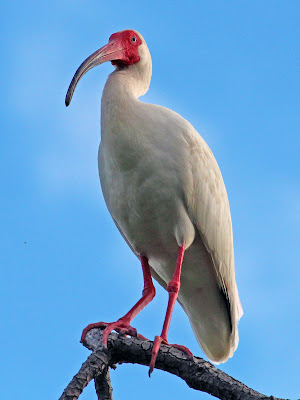 |
| White Ibis in the Wetland Cells |
Over the last several years I have been riding this route that serves as the main artery into riding the Great Trinity Forest. Naturally, this is just the most bare basic of routes and should serve as just the backbone to exploring further into the woods. 95% of the photos you see in my blog posts are taken on mountain bike rides. It’s one of the best ways to see much of the river and surrounding woods.
Other than the formal concrete trails in the area the loose confederation of existing infrastructure, streets, dirt roads and even a section of feral pig trail are open to interpretation on how to ride. At present time (spring 2013) all sections can be ridden via mountain bike or walked on foot. Some areas cannot be ridden on horseback due to lack of good ford crossings in creeks. That might need to wait another year or three.
Santa Fe Trestle Trail Bridge and Whitewater Park
The steel portion of the bridge was originally built in 1926 and served as a main artery for the AT&SF Railroad in Dallas. Some old signs along the old right of way can still be found in the overgrowth. In 1985 the trestle was burned in an overnight fire destroying over half the structure. DART purchased the railway and bridge in 1989 later deciding to build a new bridge next to the old Santa Fe trestle rather than retrofitting the existing bridge. Since that time, the Corps of Engineers has floated the idea of removing it as the bridge acts as a partial obstruction for flood debris during high water.
To access the levee trail and Santa Fe Trestle from White Rock Lake, I would suggest riding the Santa Fe Trail towards Fair Park. Through Fair Park and down Grand Avenue. Inside Fair Park, Grand Avenue is the gate closest to Big Tex and the main Fletcher’s stand. Head south out that gate. Hang a right on Lamar, left on Corinth, left on Riverfront
Miller’s Ferry
Pretty cool to see Charles Allen of Canoe Dallas rounding Miller’s Bend at Miller’s Ferry on the Trinity River as we looked on. I think it’s awesome to see two different groups of people on the river who have gone many miles downstream without using motorized transportation.
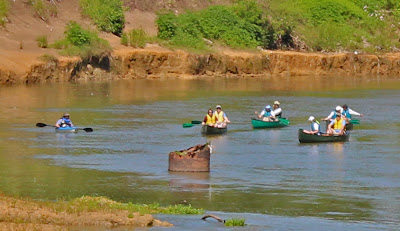 |
| Charles Allen of Canoe Dallas and his river tour approaching the old remains of the Miller’s Ferry Bridge |
Charles is back to doing canoe trips on the Main Stem of the river between Downtown and Loop 12. On the second Saturday of the month he does guided tours too, which I suspect is the case with this group. Here is his website: Trinity River Expeditions — Canoe Dallas
There should be a Texas Historical Marker for the site here. It’s a great focal point for explaining Dallas history and one of the single most important sites in Dallas African American history.
The Wetland Cells
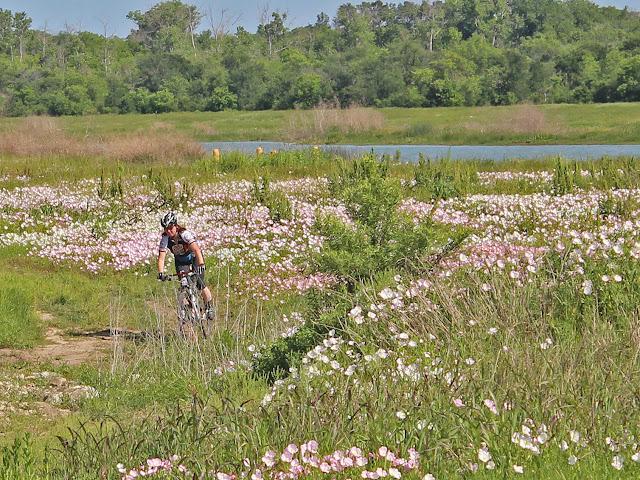 |
| Gina Porter carving trail through the Wetland Cells |
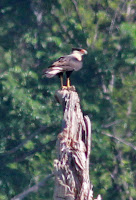 |
| Crested Caracara in the Wetlands |
The lower chain of wetlands are comprised of cells that extend from the I-45 bridge south near Miller’s Ferry to Loop 12. The wetlands are not a part of the Trinity River channel. They sit up and above grade from the Trinity. As a result the land and water are much cleaner than the river channel nearby. Until recently, it was hard to even find a piece of trash in this part of the Trinity River Project. A dirt service road skirts the wetland cells and is now seeing heavy use by 4×4 off road vehicles and illegal dumpers. The gates at Loop 12 and near Highway 310 have been broken for over a year.
 |
| Fisherman near Miller’s Ferry |
Much of the land used by the chain of wetlands was originally part of the Sleepy Hollow Golf Course and Country Club. The Chain of Wetlands extends many miles in length from Cedar Creek to Loop 12. The wetland cells located between Cedar Creek and Interstate 45 are interconnected and actually flow upstream and are continuously fed by discharge (or treated water) from the Central Wastewater Treatment Plant north of I-45. The plant’s water is treated against harmful bacteria before being discharged. The remaining wetland cells extend from the Interstate 45 vicinity to Loop 12 and are also interconnected and continuously fed by treatment plant water.
 |
| Dirt road through the Wetland Cells, Bank of America Tower seen rising above the trees in the background |
 |
| Paco Fuentes and his horse Fantasma in the Wetland Cells |
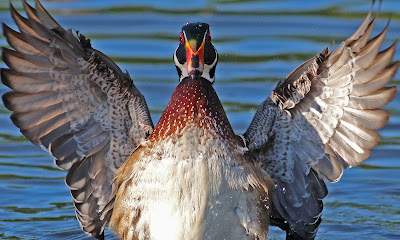 |
| Male Wood Duck |
A couple of the smaller cells south of 310 have Wood Duck nesting boxes that are starting to show success in breeding. In addition to a couple breeding pairs of Wood Ducks there has been a steady population of Blue-winged teal, Green-winged teal and even a random Cinnamon teal.
 |
| Female Wood Duck with ducklings |
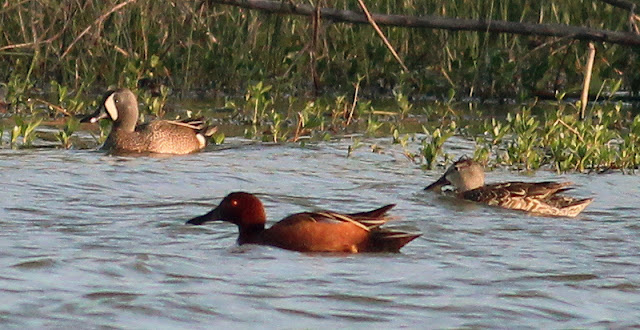 |
| Cinnamon Teal foreground, male and female Blue-winged Teal background |
Most of the gates that should be locked 24/7 in the Wetland Cells have been broken and open for over a year. One of our riding groups was treated to a demonstration in illegal dumping as a large truck pulling a trailer turned off Loop 12 and into the old Sleepy Hollow Golf Course entrance. Upon our return through the area several hours later there was a fresh pile of construction debris.
Same guys are still drinking beer and shooting the place up down there. The Dallas Police Department should have confiscated their rifles and taken them to jail last fall. Instead, they let them go. At left are the same guys, with the same rifles, drinking beer and shooting the place up in April 2013. Does the city want a wetland full of birds or one full of guys shooting the place up? How about declaring open season on poachers?
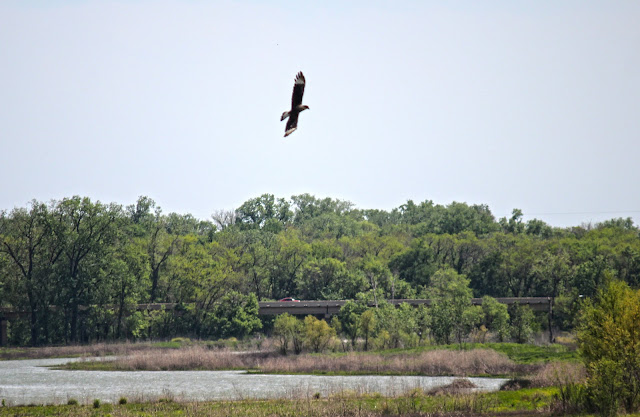 |
| Crested Caracara hunting over the Wetland Cells with Loop 12 in the background |
 |
| Crested Caracara at the Wetland Cells kicking up dust with a missed snatch of a rabbit in the grass, while a Red Tailed Hawk looks on |
Trinity Trail Through Joppa Preserve
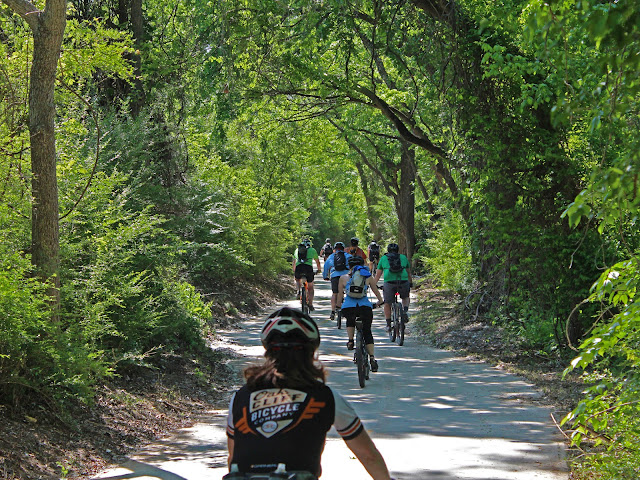 |
| Great Trinity Forest Trail in Dallas County’s Joppa Preserve |
Crossing Loop 12 to the south lies Joppa Preserve and a group of old ponds and lakes. This trail is inside the Joppa Preserve, part of the Dallas County Open Space Project. Originally this land was part of the Millermore Plantation. The original Miller cabin and the later Greek revival Millermore Mansion are now preserved at Old City Park in Dallas. The area later became known as Joppa and Floral Farms. Both were unincorporated freedman’s communities for many decades without access to running water and city services.
A paved trail completed in two phases now reach 4.1 miles to connect the Loop 12 Boat Ramp with the Trinity River Audubon Center. The centerpiece of the paved trail here is a multi-million dollar bike bridge that spans the Trinity River just southeast of the Trinity River Audubon Center.
The trail and bridge sit outside the footprint of the Audubon Center property. The formal trailhead for the Audubon section sits roughly 400m south of the Audubon entrance in a separate parking lot.
NOTE: No mountain biking or horseback riding inside the Audubon Center property. You must stay on the pavement. Also, the Audubon Center is a privately run facility and there is admission fee to visit and hike the trails there.
Trinity River Audubon Center
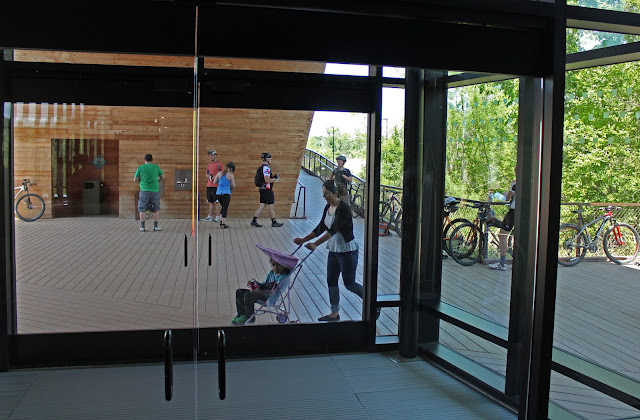 |
| View of the breezeway from inside the Audubon Center |
 |
| Ben Jones at left with DORBA and FWMBA members at the Audubon Center |
The Audubon Center has outdoor bathroom facilities and water fountains. I think it still sits as an undiscovered resource for the Great Trinity Forest. A bit of civilization among the wilderness beyond. It should serve as a great jumping off point for those wanting to make a jump into the forest beyond.
Ben Jones the director of the Trinity River Audubon Center was kind enough to spend some time with us(inset left) and spoke of some of the activities planned for the Audubon Center this summer. Big thanks to Ben for taking time out of his busy day to visit with us!
Trinity River Audubon Center’s new canoe takeout
Most exciting is the new canoe takeout that the Audubon Center has built at the river and guided river trips they are offering starting June 1st. The route would be Loop 12 to the Audubon Center and cover some of the most scenic stretches of the river. They also have a new campsite in the works for overnight stays on the river.
Watch the Audubon Center’s website for more information http://trinityriver.audubon.org/
From the Audubon Center to McCommas Bluff
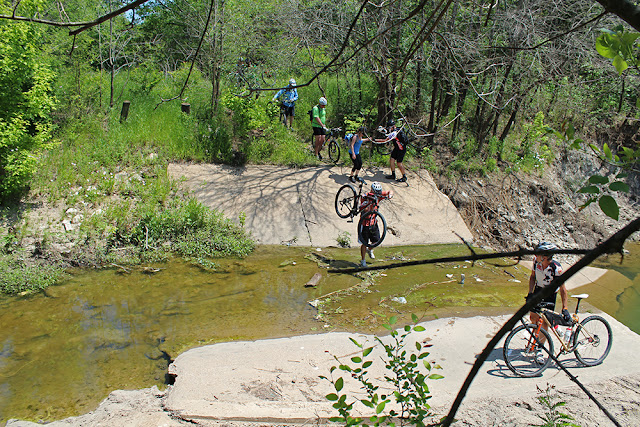 |
| Crossing Elam Creek and the concrete culvert that separates the Audubon Center property from McCommas Bluff Preserve |
Off the beaten path time. Takes a leap of faith for most to venture off the pavement and into hip deep grass and woods. There is a great route from the Audubon Center to McCommas Bluff but often hard to follow the first 100 feet off the pavement. Refer to the map links at the beginning of the post on how to get there. The entrance is where the paved path takes a turn to the south from the Audubon Center about 250m from the north end of the Trinity River Trail Bridge. The goal here is to find a concrete culvert crossing of Elam Creek. As seen above the crossing has a little water in it but is hardly enough to even get your feet wet.
 |
| Riding McCommas Bluff Preserve |
Beyond is a doubletrack dirt road that follows a Dallas Water Utilities ROW through McCommas Bluff Preserve. An alternate dirt road leads up through the preserve to Fairport. The lower road follows the ROW down to Riverwood Road and along some great woods.
 |
| Mexican Buckeye at McCommas Bluff Preserve |
The doubletrack follows an old terrace and as one approaches the old Bass Family pond there is a large colony of Mexican Buckeye just up on the sandy terrace above. You don’t see many Mexican Buckeye in the Great Trinity Forest, these are easy to spot during the spring.
 Elam Creek up towards Fairport also has a colony of Texas Buckeye. These are pretty hard to find tucked deep in among the privet of the area.
Elam Creek up towards Fairport also has a colony of Texas Buckeye. These are pretty hard to find tucked deep in among the privet of the area.
Noted Master Naturalist Jim Flood told me about the Texas Buckeyes back here along Elam Creek this spring. I lucked out and was able to find them, with a little trouble.
 2013 was a great year for Buckeye blooms. The prolonged cold weather through March and April made for a very long blooming season, weeks longer than last year.
2013 was a great year for Buckeye blooms. The prolonged cold weather through March and April made for a very long blooming season, weeks longer than last year.
McCommas Bluff to I-20
The traverse from McCommas Bluff to I-20 is closed to vehicle traffic but open to bikes, foot traffic and especially horses. Those wanting to ride horses on the river should take advantage of the route here that skirts behind a cemetery to the bluff tops of McCommas Bluff.
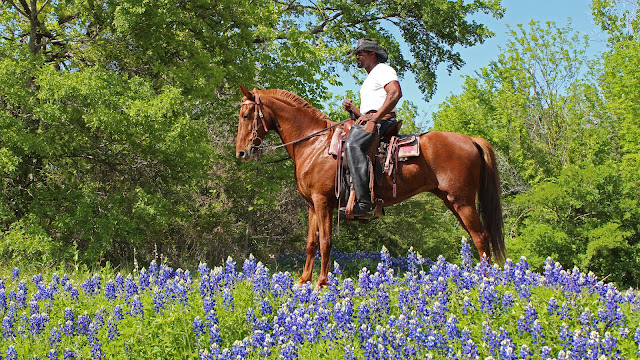 |
| BJ Wakefield surveying the Trinity River from the top of McCommas Bluff |
 |
| David Miller |
A man in Joppa told me several years ago that the land down near the bluffs was once some of the finest squirrel hunting grounds in Texas. So ripe was the hunting that a man could hunt squirrel after church on Sunday afternoons and eat squirrel stew all week.
From the porch of his shotgun house he told me a number of stories like that, things gone by you don’t see too much of anymore. I always savored the moments of being there, seeing it, absorbing it. Figuring that through his old cobweb of recollection in storytelling I could imagine a man on horseback overlooking those bluffs way back when.
I could picture his mental map of riding the river on a horse during the 1920s, long before the roads and landfills were there. Rare is the day to see that in modern times. A special thanks to Mr David Miller and friends for allowing me to chat with them on a ride. Double neat to see that old story come to life one fine weekend afternoon.
 |
| McCommas Bluff |
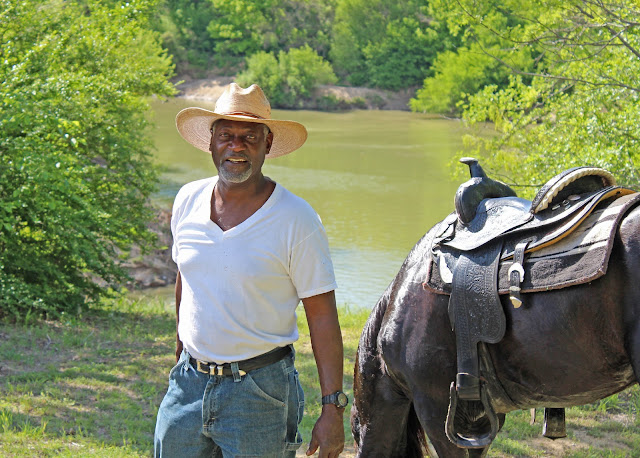 |
| David Miller at McCommas Bluff |
 |
| David Miller in the foreground watching some boaters rounding the bend of the Trinity River |
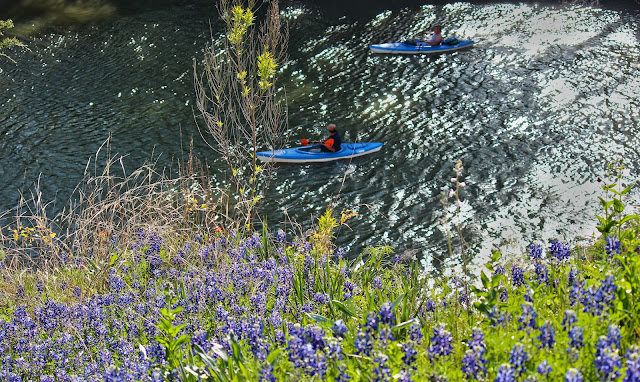 |
| Kayakers at McCommas Bluff |
 |
| The last of the wildflowers that were not bulldozed by a Dallas Water Utilities project |
The new Trinity River park at I-20
 |
| The new I-20 park at Dowdy Ferry and I-20 |
With an expected opening date of June 8, 2013, a new park will open at Dowdy Ferry and I-20. I have heard the the park go by a number of names like Gateway Park, Trinity River Park etc. The centerpiece of the park is a small lake of a few acres that was once a gravel pit. Limestone cliffs on one side and a small island on the northeast end that can be reached in drier weather by a spit of land.
With a gazebo, fishing pier and a short looped concrete hiking trail it should be popular. Also of note is a large trailer parking area and hitch posts for those with horses. Off in the woods there to the west is a new official-informal trail that leads back into the woods. I have ridden a mountain bike through there and about two miles of trails can be strung together with a little work. Tree shaded and flat the only thing to watch out for is the large amount of illegally dumped trash back there. Some might claim it floated in. The reality is years of not keeping gates locked allowed the dumping to occur.
 |
| View from the fishing pier |
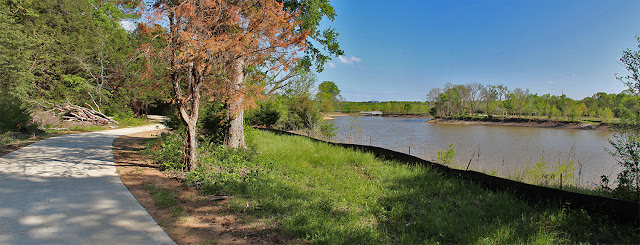 |
| Concrete trail that loops around the pond |
This is the turn around point for the ride. Roughly 22 miles or so from White Rock Lake’s Spillway. The ride back can be done a number of ways, following the course back up the Trinity River or maybe up through Pleasant Grove or Parkdale. Our route takes us to the historic Pemberton Farm.
The Pemberton Farm and Big Spring
 |
| Zada and Billy Ray Pemberton welcoming everyone to their home |
 Not many people have ever met a Dallas farmer inside the city limits or even knew one existed. A family who still grow their own food to a large extent, work the fields and tend to livestock. Well, here they are. The Pembertons. Seems like I write about them a lot here. Seems that whenever I take others down here, their after-visit emails always highlight not on the wild animals or sites we visit but the Pemberton Farm. Zada Pemberton had candy, walnut bread and water waiting for us. Who still does that? No one. Except the Pembertons.
Not many people have ever met a Dallas farmer inside the city limits or even knew one existed. A family who still grow their own food to a large extent, work the fields and tend to livestock. Well, here they are. The Pembertons. Seems like I write about them a lot here. Seems that whenever I take others down here, their after-visit emails always highlight not on the wild animals or sites we visit but the Pemberton Farm. Zada Pemberton had candy, walnut bread and water waiting for us. Who still does that? No one. Except the Pembertons.
It’s that special of a place. Rolling down the slight hill towards the bottoms, the sounds of the city quickly fade away. So quiet of a spot that you not only hear the call of the birds, you hear their wings flap as they fly through the air.
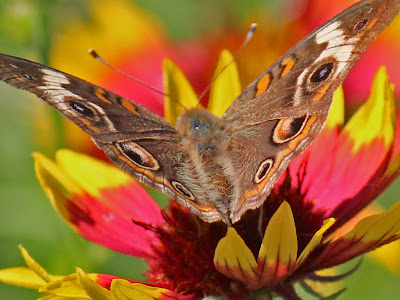
On the most recent visit to Big Spring we were treated to the steady hooting calls of the resident Barred Owls in the woods beyond. Whole weeks and sometimes a calendar month can go by without this area seeing a human. Real wilderness.
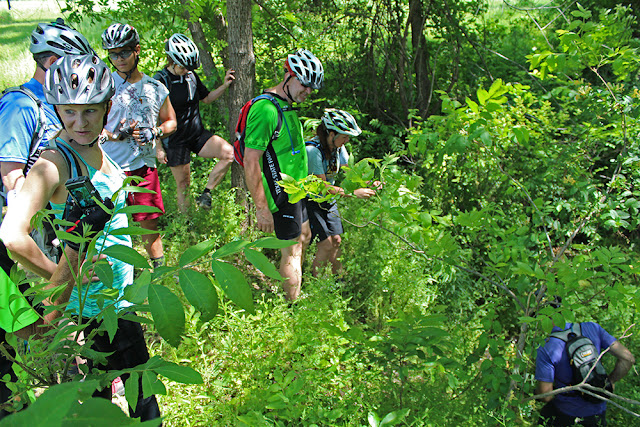 |
| Taking turns climbing down into Big Spring to drink the water |
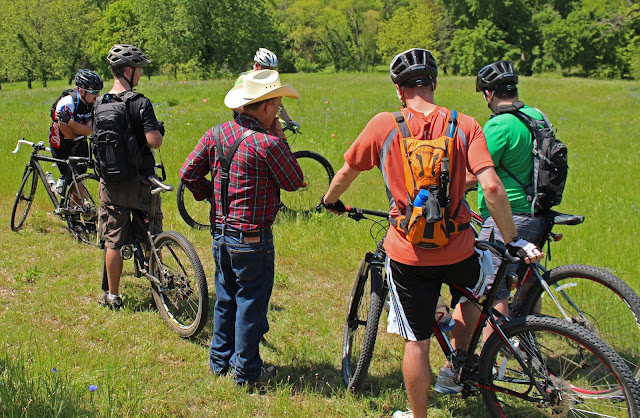 |
| Mr Pemberton talking pioneers and Native Americans at the Spring Pasture |
You see that photo above? The 1000 yard stare on the faces of everyone thinking and pondering the 100 generations of people who once called that spot of land home. A real Native American pre-historic site. Right at our feet. It’s only there because of Billy Ray. It would have been gone long ago without his oversight.
| The Bur Oak at Big Spring |
Those who have not been there cannot grasp the size and scope of such a place. With no fences, barricades or man made features nearby one can only gain perspective of such a place by visiting the site. Above you can see in the far distance someone walking not far from the Bur Oak. The spring site is that large and just the water feature encompasses a few acres. Free to flow whichever way it wants, the meander of the spring had historically run a number of different ways many tens of meters away from the current course.
| One of three spots where Big Spring flows out of the ground atop a limestone bedrock |
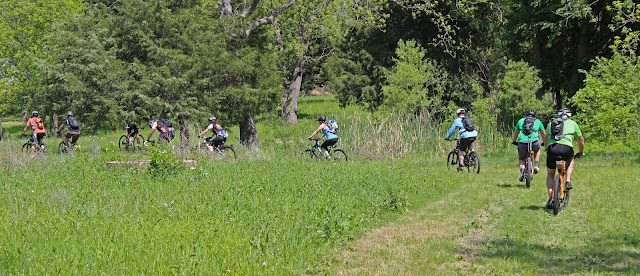 |
| Riding in the same spot as President Sam Houston, 170 years later |
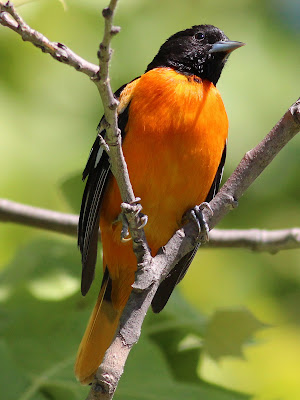 |
| Baltimore Oriole |
With news of a fence planned to protect Big Spring, where would one build such a structure and why?
Big Spring serves as a water source for larger animals like native deer. A fence would keep them out. River Otter tracks seen in the spring suggest that they fish for crawfish in the spring. How would they get in?
It’s a place that has never needed a sign to read. Nor a plaque to note the spot or a historical background. It’s already marked. The ancient Bur Oak. The Native American artifacts all over the place. The Black Walnut with the spike driven in it for the high watermark of the 1908 flood. It could never be confused with another spot. You know when you have found the place.
 |
| Dicksissel (Spiza americana) at Big Spring |
I have slowly watched parts of the Great Trinity Forest change over the years. Some good, some bad. I’d ask what the future holds and will we look back decades from now and see it as a bad idea? I miss the old dirt roads already. A time when I could ride along with honest salt of the Earth cowboys riding through the woods.
That same trail, that exact same spot looks so much different now, like Plano. Gone are the horses and the cool guys who sung their Spanish ballads as they rode through wildflowers. Replaced by sterile concrete and rye grass. Unused to a large degree. Are we going the right way with all this?



